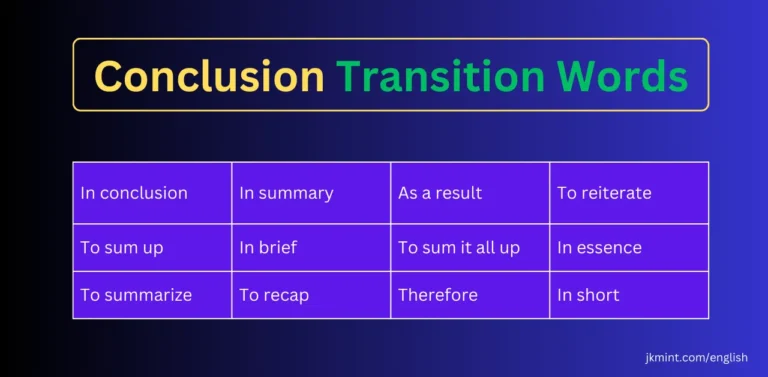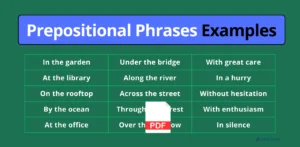Transition Words for the Conclusion of essays, and paragraphs, serve as signposts to indicate that you’re reaching the end of your discussion or argument. They help you summarize your main points and provide a smooth transition to your final thoughts.
Here are some best conclusion transition words you can use In Conclusion, To Conclude, To Sum Up, Ultimately, As a result, Therefore, In short, To Recap, etc.
| 1. In conclusion | 11. In summary | 21. To draw a conclusion | 31. To reiterate |
| 2. To sum up | 12. In brief | 22. To sum it all up | 32. In essence |
| 3. In summary | 13. To recap | 23. In the grand scheme of things | 33. In short |
| 4. To conclude | 14. To put it simply | 24. In the final reckoning | 34. In a final note |
| 5. Ultimately | 15. In the end | 25. To bring matters to a close | 35. Conclusively |
| 6. As a result | 16. In the final analysis | 26. In the long run | 36. To put things in perspective |
| 7. Therefore | 17. All things considered | 27. To put things in perspective | 37. To bring everything full circle |
| 8. Hence | 18. In retrospect | 28. To sum it all up | 38. To sum it all up |
| 9. In a nutshell | 19. Taking everything into account | 29. To close | 39. In retrospect |
| 10. All in all | 20. In a word | 30. To reiterate | 40. To sum it all up |
See Also: Transition Words to Start a Paragraph
Good Transition Words for Conclusion:
The perfect list of good and best transition words for the conclusion of sentences, essays, paragraphs, notes, and emails with examples and usages.
1. In conclusion:
Usage: This classic phrase signals that you’re about to sum things up.
Example: In conclusion, the evidence strongly supports our hypothesis.
2. To sum up:
Usage: It’s a concise way to wrap up your ideas.
Example: To sum up, the key takeaways from this study are…
3. In summary:
Usage: Similar to “In conclusion,” this phrase provides a quick overview of your main points.
Example: In summary, our marketing strategy has been highly effective.
4. To conclude:
Usage: This signals your intent to bring your argument to a close.
Example: To conclude, the impact of climate change on ecosystems is undeniable.
5. Ultimately:
Usage: It suggests that you’re arriving at the final point or outcome.
Example: Ultimately, this new policy will benefit both employees and the company.
6. As a result:
Usage: When you want to show cause and effect in your conclusion, use this phrase.
Example: As a result, we’ve seen a significant increase in customer satisfaction.
7. Therefore:
Usage: It signifies a logical conclusion based on the preceding information.
Example: Therefore, it’s clear that changes are needed to improve the current situation.
8. Hence:
Usage: Similar to “therefore,” it indicates a logical consequence.
Example: Hence, our decision to expand into new markets is well-founded.
9. In a nutshell:
Usage: A colloquial way to summarize.
Example: In a nutshell, our project was a resounding success.
10. All in all:
Usage: An informal but effective way to conclude.
Example: All in all, the conference was a valuable experience.
11. In summary:
Usage: Another alternative to signal summarization.
Example: In summary, our research highlights the need for further investigation.
12. In brief:
Usage: A concise way to wrap up your main points.
Example: In brief, the results show a clear trend towards sustainability.
13. To recap:
Usage: Informal and friendly, it helps review key ideas.
Example: To recap, our journey has been filled with challenges and triumphs.
14. To put it simply:
Usage: A straightforward way to simplify complex ideas.
Example: To put it simply, the market is highly competitive.
15. In the end:
Usage: Signifies the ultimate result or outcome.
Example: In the end, hard work and determination paid off.
16. In the final analysis:
Usage: A more formal way to signal a conclusion.
Example: In the final analysis, the data supports our hypothesis.
17. All things considered:
Usage: Indicates careful consideration of all factors.
Example: All things considered, the benefits outweigh the risks.
18. In retrospect:
Usage: Reflecting on past events or ideas.
Example: In retrospect, our decision to invest in technology was wise.
19. Taking everything into account:
Usage: Emphasizes comprehensive analysis.
Example: Taking everything into account, the project was a success.
20. In a word:
Usage: Concise and to the point.
Example: In a word, the outcome was unexpected.
21. To draw a conclusion:
Usage: More active phrasing.
Example: To draw a conclusion, this study reveals significant trends.
22. To sum it all up:
Usage: Emphasizes totality.
Example: To sum it all up, our achievements have been remarkable.
23. In the grand scheme of things:
Usage: Highlights broader context.
Example: In the grand scheme of things, this is just a small setback.
24. In the final reckoning:
Usage: Suggests a final judgment.
Example: In the final reckoning, honesty prevails.
25. To bring matters to a close:
Usage: Indicates the intent to conclude.
Example: To bring matters to a close, let’s review our main findings.
26. In the final analysis:
Usage: A formal way to signal the conclusion.
Example: In the final analysis, the data supports our hypothesis.
27. To summarize:
Usage: “To summarize” is a clear and concise way to wrap up your main points.
Example: To summarize, the study’s findings are significant.
28. To wrap it up:
Usage: An informal way to signal the conclusion of your discussion.
Example: To wrap it up, let’s review the main findings from the experiment.
29. To bring it all together:
Usage: This phrase emphasizes consolidating various ideas or elements.
Example: To bring it all together, our team integrated design and functionality seamlessly.
30. To close:
Usage: A concise way to signal the end of your discussion or presentation.
Example: To close, I’d like to thank everyone for their contributions to this project.
31. To reiterate:
Usage: Use this phrase to emphasize the repetition of key points.
Example: To reiterate, our main objective is to provide quality service.
32. In essence:
Usage: Get to the core of your argument.
Example: In essence, our proposal aims to improve efficiency.
33. In short:
Usage: A succinct way to sum things up.
Example: In short, we’re on track to meet our goals.
34. In a final note:
Usage: Signifies the last thought on the topic.
Example: On a final note, this issue deserves further attention.
35. Conclusively:
Usage: Adds a formal touch to your conclusion.
Example: Conclusively, our study confirms the theory.
36. In the long run:
Usage: Highlights long-term consequences.
Example: In the long run, sustainability will be crucial.
37. To put things in perspective:
Usage: Provides context for your conclusion.
Example: To put things in perspective, this is just one part of the puzzle.
38. To bring everything full circle:
Usage: Emphasizes completion or return to the starting point.
Example: To bring everything full circle, let’s revisit our initial objectives.
39. To sum it all up:
Usage: Reinforces the idea of totality.
Example: To sum it all up, our efforts have been worthwhile.
40. In retrospect:
Usage: Reflects on past events or ideas.
Example: In retrospect, our decision to expand globally was strategic.
These conclusion transition words, when used appropriately, will enhance the clarity and coherence of your writing, whether you’re composing essays, paragraphs, sentences, reports, or blog posts.
See Also: Transition Words for Counterarguments
Summary
Conclusion transition words are essential tools for writers of all levels. They provide a clear roadmap for your readers, making your writing more coherent and persuasive.
Whether you’re crafting paragraphs or essays, using these words will help you leave a lasting impression and ensure your ideas are communicated effectively.




